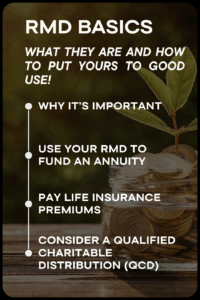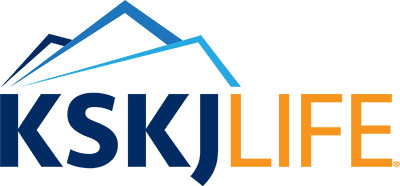October 31, 2025
RMD Basics:
What They Are and How to Put Yours to Good Use
What Is an RMD?
If you have a tax-deferred retirement account — such as a traditional IRA, 401(k), or 403(b) — the IRS requires you to begin taking Required Minimum Distributions (RMDs) each year once you reach a certain age.
As of 2025, individuals generally must start taking RMDs at age 73 (rising to 75 in 2033 for those born in 1960 or later). These withdrawals are designed to ensure that taxes are eventually paid on the money you’ve been saving tax-deferred all these years. Your RMD amount is based on your account balance and life expectancy, as determined by IRS tables.
Why It’s Important
Failing to take your full RMD can result in a steep penalty from the IRS. That’s why it’s critical to understand your RMD requirements each year, even if you don’t need the money for daily expenses.
If You Don’t Need Your RMD for Living Expenses
Some retirees find they don’t actually need the income from their RMDs to cover regular costs. The good news? You have several smart ways to put those funds to work — including options that align with your long-term goals or help you leave a legacy.
 1. Use Your RMD to Fund an Annuity
1. Use Your RMD to Fund an Annuity
An annuity can convert a lump sum (like your RMD) into a steady stream of income — guaranteed for life or a set number of years. If you already have enough income for now, you could consider a deferred annuity, like a KSKJ Life Multi-Year Guaranteed annuity, that allows your money to continue growing tax-deferred until you need it. While you can’t reinvest an RMD directly into the same IRA, you can use it to purchase an after-tax annuity that provides future security.
2. Pay Life Insurance Premiums
While RMD funds cannot directly purchase life insurance, they can be used to pay life insurance premiums after the required distribution is withdrawn and taxes are paid. This strategy can help you create a legacy for your loved ones or offset the tax impact of your RMDs. Using RMD funds to pay premiums on a life insurance policy – like KSKJ Life’s Precision Plan products – can be an effective way to transfer wealth tax-efficiently to your beneficiaries. This can help offset taxes that heirs may owe on inherited retirement accounts, or simply provide a lasting legacy.
3. Consider a Qualified Charitable Distribution (QCD)
If you’re age 70½ or older, you can choose to have funds from your IRA sent directly to a qualified charity* instead of taking that amount as taxable income. This type of distribution can satisfy part or all of your RMD while allowing you to support a cause you care about. Because the money goes straight from your IRA to the charity, it’s excluded from your taxable income, which can be especially beneficial if you don’t itemize deductions or want to keep your adjusted gross income lower.
The Bottom Line
RMDs are an inevitable part of retirement, but they don’t have to be a burden. With a little planning, you can use your required withdrawals to strengthen your financial plan, support your loved ones, or make a difference through charitable giving.
If you’re exploring ways to make the most of your RMDs, talk with a KSKJ Life representative. We can help you understand how an annuity or life insurance policy may fit your goals — in coordination with your financial or tax advisor.

